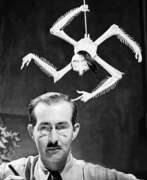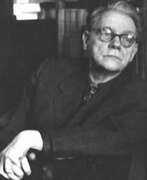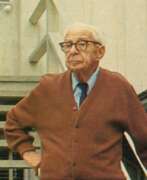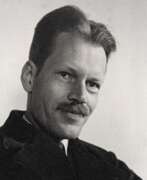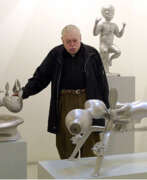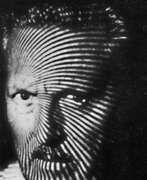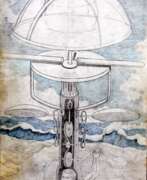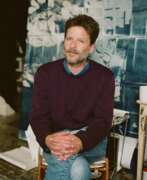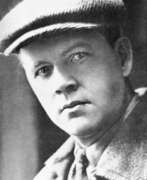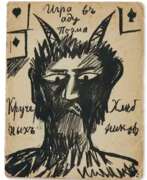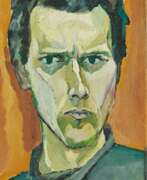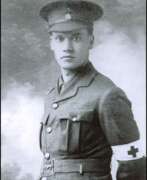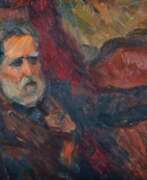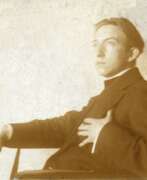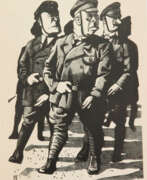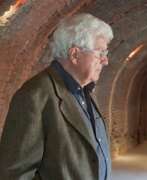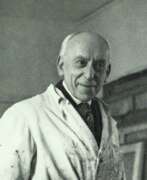Graphic artists Futurism
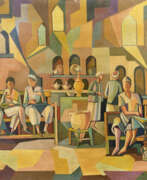

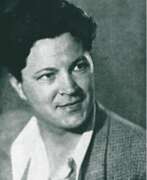

Fyodor Semyonovich Bogorodsky (Russian: Фёдор Семёнович Богородский) was a distinguished Russian painter, graphic artist, and theatrical designer, celebrated for his contributions to Soviet art. Born in Nizhny Novgorod and initially studying law at Moscow University, Bogorodsky's passion for art led him to VKhUTEMAS, where he honed his craft under notable figures such as A.E. Arkhipov. His unique journey included serving as a sailor and pilot during World War I, which profoundly influenced his art, often depicting sailors as his main subjects, a testament to his own experiences and admiration for their lifestyle.
Bogorodsky's artistry earned him the title of Honored Artist of the RSFSR in 1946, and his work "Glory to Fallen Heroes" received the prestigious Stalin Prize in 1945, later commemorated on a Soviet postage stamp in 1965. His commitment to depicting the valor and hardships of the Soviet people, especially sailors and the underprivileged, made him a significant figure in the realm of Soviet realism.
His works are preserved in esteemed collections, including the State Tretyakov Gallery and the State Russian Museum, showcasing his contributions to Soviet art and culture. Bogorodsky's legacy extends beyond his paintings, as he also made significant contributions to the fields of teaching, poetry, and theater.
For collectors and experts in art and antiques, Fyodor Bogorodsky remains a symbol of the intertwining of art, history, and personal experience. His dedication to capturing the essence of Soviet life, coupled with his remarkable technique, ensures his place in the annals of art history. Sign up for updates on new product sales and auction events related to Fyodor Semyonovich Bogorodsky to further explore the depth of his works and their impact on Soviet art.
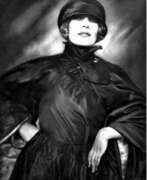

Kseniya Leonidovna Boguslavskaya (Russian: Ксения Леонидовна Богуславская) was a twentieth-century Russian artist who lived and worked in Germany and France for most of her career. She is known as a painter, graphic artist, theatrical artist and designer, and poetess.
Kseniya Boguslavskaya was a representative of the avant-garde school. She created semi-abstract cubo-futuristic compositions, including landscapes, still lifes, genre scenes, and images of interiors. In the same style, the artist drew sketches for articles of applied art. She also illustrated covers of publications and worked as a scenographer.


Hans Brass was a German artist of the first half of the twentieth century. He is known as a painter and graphic artist, famous for his expressionist works.
Hans Brass created landscapes in a traditional style at the beginning of his career. However, between 1917 and 1923 he turned to Expressionism, Cubism and Futurism. From 1921 he became interested in abstract art, and until 1933 he created abstract works and works with religious content. By 1948 Brass had developed his own unique style based on his expressionist experience. From 1952 he worked in watercolor, depicting landscapes and flowers.
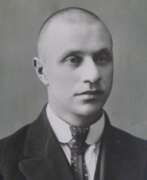

Vladimir Davydovych Burliuk (Russian: Владимир Давидович Бурлюк) was a Ukrainian avant-garde artist, known for his contributions as a Neo-Primitivist and Cubo-Futurist. Born on March 27, 1886, in the Russian Empire, Burliuk's work spanned various mediums, including painting and book illustration. His art is celebrated for its bold experimentation and pioneering spirit in the early 20th century avant-garde movement. Burliuk's life was tragically cut short when he died at the age of 32 during World War I in 1917.
Burliuk's artistic output is characterized by its innovative approach and his involvement in the avant-garde circles that radically transformed Russian art. His works were part of significant avant-garde exhibitions and movements, showcasing his commitment to pushing the boundaries of traditional art. Among his notable works are contributions to publications and exhibitions that captured the essence of the avant-garde, such as "Sadok Sudei (A Trap for Judges)" in 1910 and "Moloko kobylits (Milk of Mares)" in 1914. His art is recognized for its unique body of works, blending Cubism, Rayonism, and elements of Futurism, marked by stylistic unity and high valuation by connoisseurs.
Burliuk's legacy extends beyond his own creations; his involvement with key figures and movements of the time, including his brother David Burliuk, further emphasizes his role in shaping modern art. Despite his early death, Vladimir Burliuk's work remains a testament to the vibrancy and dynamism of the avant-garde movement, with his pieces held in high regard by collectors and experts alike.
For those interested in exploring the depths of avant-garde art, Burliuk's oeuvre offers a fascinating glimpse into the revolutionary spirit of early 20th-century artistic exploration. His contributions continue to inspire and intrigue art lovers, underscoring the lasting impact of his brief but impactful career.
Sign up for updates to stay informed about new product sales and auction events related to Vladimir Davydovych Burliuk, and immerse yourself in the world of avant-garde artistry that continues to resonate with collectors and art enthusiasts alike.
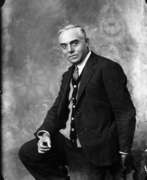

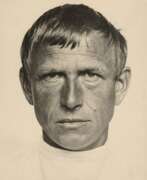

Wilhelm Heinrich Otto Dix was a German artist whose work stands as a stark, unyielding reflection of the societal tumult and trauma of the early 20th century. Born in 1891 in Untermhaus, Germany, Dix's early life was steeped in the arts, his ambition to become an artist nurtured by both familial influence and formal education in Dresden. His experiences as a soldier in World War I deeply influenced his artistic direction, leading him to vividly depict the horrors of war and the decay of the Weimar Republic with a brutal realism that became his signature style.
Dix's association with the Dada movement and the New Objectivity (Neue Sachlichkeit) further honed his critical, often cynical portrayal of post-war society. His works, such as "The Trench" and "War Cripples," expose the visceral aftermath of conflict, while his engagement with the Dadaists imbued his art with a disruptive, confrontational energy against societal norms and the art establishment.
Perhaps most notable is Dix's ability to capture the psychological depth and societal critiques through his portraits and landscapes, which ranged from the grotesque to the surreal. Paintings like "Portrait of the Journalist Sylvia von Harden" and the triptychs "Metropolis" and "War" are emblematic of his keen observation and stark depiction of the era's social and political unrest.
Despite facing significant adversity, including being labeled a degenerate artist by the Nazi regime and facing professional and personal setbacks, Dix's legacy as a painter and printmaker endures. His works are not only historical documents but also profound reflections on humanity, war, and society, resonating with collectors and art experts alike.
For enthusiasts of culture, art, and history, Dix's oeuvre offers an unflinching look into the human condition under the strain of societal and political upheaval. His contributions to painting and printmaking continue to be celebrated in museums and galleries worldwide, underscoring the enduring relevance of his work.
For those interested in exploring the profound depth and historical significance of Otto Dix's work, signing up for updates on new product sales and auction events related to his art can provide invaluable insights. This subscription is a gateway to staying informed about opportunities to engage with the tangible pieces of Dix's enduring legacy.
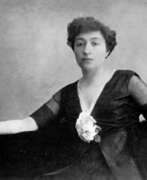

Aleksandra Aleksandrovna Ekster (Russian: Алекса́ндра Алекса́ндровна Эксте́р), a luminary of the Russian avant-garde, was a painter and designer whose work traversed the boundaries of Cubo-Futurism, Suprematism, and Constructivism, eventually influencing the Art Deco movement. Born in Białystok (then part of the Russian Empire, now Poland) and later splitting her life among Kiev, St. Petersburg, Moscow, Vienna, and Paris, Ekster played a pivotal role in bridging Russian and European artistic movements. Her innovative approach to art was characterized by dynamic movement, vibrant color contrasts, and geometric compositions, which were evident in her paintings, theater set and costume designs, and educational endeavors.
Ekster's studio became a hub for the intellectual and artistic elite, hosting figures like poets Anna Akhmatova and Osip Mandelstam, as well as painters Pablo Picasso and Georges Braque during her stays in Paris. Her involvement in significant art exhibitions, such as the Salon des Indépendants and the Salon de la Section d'Or in Paris, showcased her works alongside those of Jean Metzinger, Marcel Duchamp, and others, marking her as a key figure in the avant-garde community.
Beyond painting, Ekster's contributions to theater and design were profound. She worked on costume and set designs for Alexander Tairov's Chamber Theatre and participated in the revolutionary festivities' decoration in Kiev and Odessa. Ekster's pedagogical efforts included teaching at the Higher Artistic-Technical Workshop (VKhUTEMAS) in Moscow, fostering a new generation of avant-garde artists.
Ekster's work is housed in various international and private collections, reflecting her lasting impact on the art world. Her ability to integrate different genres and styles, along with her commitment to experimentation and innovation, made her one of the most influential women in the Russian avant-garde.
For those fascinated by the pioneering spirit of Aleksandra Aleksandrovna Ekster and the avant-garde movement, signing up for updates on new product sales and auction events related to her work is a compelling way to stay informed. This subscription ensures enthusiasts and collectors are always in the loop regarding opportunities to engage with Ekster's enduring legacy.
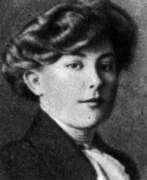

Vera Mikhailovna Ermolaeva (Russian: Ве́ра Миха́йловна Ермола́ева) was a Russian avant-garde artist, illustrator, and educator, renowned for her contributions to children's literature and modern art. Born in the village of Klyuchi, she emerged as a pivotal figure in the Russian avant-garde movement, known for her innovative approaches to book illustration and her role in shaping early 20th-century art education and theory.
Ermolaeva's career is marked by her significant involvement with the book-publishing studio "Today" (Segodnya) in Petrograd, where she, alongside other notable artists, produced hand-crafted picture books and lubki. Her illustrations for children's books, such as those written by Natan Vengrov and Alexander Vvedensky, reflect a unique blend of narrative and visual artistry, contributing to the development of a new genre of children's literature.
In addition to her illustration work, Ermolaeva's influence extended to art education. She played a crucial role at the Vitebsk Art School, inviting Kazimir Malevich to teach and eventually leading the institution. Her efforts alongside Malevich and others facilitated the formation of UNOVIS, a collective dedicated to exploring and promoting avant-garde art principles.
Ermolaeva's theoretical and practical work in the field of color theory at the State Institute of Artistic Culture (GINKHUK) further underscores her contributions to modern art. Her association with the "Association of Real Art" (Oberiu) and her involvement in creating avant-garde art circles highlight her commitment to exploring the intersections between art, theory, and society.
Her works, including "Still Life" and "The Concert. Composition on the Theme of Bernardino Licinio," are held in prestigious collections, such as the State Russian Museum, the State Tretyakov Gallery, the Pushkin Museum, the Museum of Modern Art (MoMA), and the Ludwig Museum, showcasing her enduring legacy in the art world.
For collectors and experts in art and antiques, Ermolaeva's story and creations offer a window into the vibrant world of the Russian avant-garde. Her dedication to art education, innovative approach to book illustration, and contributions to modern art theory make her a fascinating figure in the history of art.
To stay updated on new findings and auction events related to Vera Mikhailovna Ermolaeva's work, sign up for updates. This subscription will keep you informed about new product sales and auction events, allowing you to deepen your appreciation and understanding of this remarkable artist's legacy.
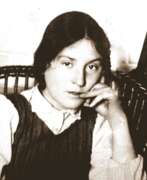

Nina Henrichovna Genke-Meller (Russian: Нина Генриховна Генке-Меллер) was a distinguished Ukrainian-Russian avant-garde artist, celebrated for her contributions as a Suprematist, Futurist, designer, graphic artist, and scenographer. Born on April 19, 1893, in Moscow, she emerged as a pivotal figure in the avant-garde movement, significantly influenced by the political and cultural upheavals of her time. Her multifaceted career took off after the October Revolution of 1917 when she actively participated in decorating the streets of Kyiv and Odesa for Revolution festivities alongside contemporaries like Aleksandra Ekster and Kliment Red'ko. Genke-Meller's artistic endeavors spanned various domains, including her role as a chief artist at the Golfstream futuristic publishing house, her pioneering work in graphic design, and her significant contributions to stage design, ceramics, and wallpaper manufacturing.
Her teaching stint at the All-Ukrainian State Center Studio from 1920 to 1924 marked a notable period in her career, where she influenced many through her artistic philosophies and practices. By 1924, Genke-Meller had moved to Moscow, further expanding her creative horizons as a stage designer and taking up roles in the decorative and applied arts. Her legacy includes a rich body of work that encapsulates the spirit of the avant-garde movement, with notable exhibitions showcasing her contributions to Ukrainian and Russian avant-garde art across various esteemed platforms like the National Art Museum of Ukraine, Villa Stuck in Munich, and The Ukrainian Museum in New York.
For collectors and experts in art and antiques, Nina Henrichovna Genke-Meller's works represent the revolutionary zeal of the avant-garde movement, offering a glimpse into the transformative power of art in the early 20th century. Her contributions continue to inspire and influence contemporary discussions on art and design, cementing her status as a key figure in the avant-garde narrative.
For those interested in exploring the profound impact and timeless appeal of Genke-Meller's art, signing up for updates related to her work offers an exclusive gateway to new product sales and auction events, providing collectors and enthusiasts with timely insights into the vibrant legacy of this avant-garde icon.
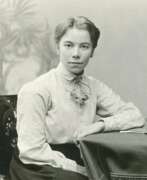

Elena Genrikhovna Guro (Russian: Еле́на Ге́нриховна Гуро́), born in 1877 in St. Petersburg, Russia, and passing in 1913, was a pioneering figure in the Russian Futurist movement. As a multifaceted artist, she delved into painting, writing, and poetry, marking her as a versatile and innovative force in the early 20th century Russian avant-garde. Guro's work is distinguished by its embrace of Futurism, a movement that sought to break away from traditional art forms and explore dynamic means of expression. Her contributions were not only limited to visual arts but also extended to literature, where she experimented with narrative forms and language, often incorporating nonsensical elements to challenge conventional aesthetics.
Guro's literary works, such as "The Little Camels of the Sky," demonstrate her experimental approach to language and form, embodying the Futurist fascination with the aesthetic possibilities of words. This approach is evident in her poetry and short stories, where she utilized single-word sentences and nonsense words to capture the essence of moments or convey a childlike perspective. Such techniques allowed her to explore the texture of language and its visual and auditory qualities, making her work resonate with the innovations of the Futurist and Dada movements.
Despite her early death at the age of 36, Guro's legacy continues to be celebrated for its contribution to the evolution of Russian modernism. Her work bridged the gap between the Symbolist movement and Futurism, contributing significantly to the dialogue around art and literature in her time. Her husband, Mikhail Matyushin, further propagated her artistic theories, ensuring that her innovative approach to color and form continued to influence Russian art and literature after her passing.
Elena Genrikhovna Guro remains an inspirational figure in the world of art and literature, embodying the spirit of innovation and exploration that defined the early 20th century avant-garde. Her works, which blend poetic language with vivid imagery, invite audiences to reconsider the boundaries between different art forms and the potential of language as an artistic medium.
For those intrigued by the rich tapestry of Russian Futurism and the unique voice of Elena Guro, signing up for updates on her works, sales, and auction events can deepen your appreciation and understanding of this pivotal artist's contributions. This subscription will ensure you stay informed about the latest insights and opportunities related to Elena Genrikhovna Guro's enduring legacy.


Ivan Vasilievich Kliun (Russian: Иван Васильевич Клюн) was a seminal figure in the Russian Avant-Garde movement, a painter, sculptor, and art theorist associated with Suprematism, a movement that sought to break down art into its basic geometric components. Born in Bolshiye Gorki, Kliun was deeply involved with the avant-garde circles that revolutionized Russian art in the early 20th century. His journey into the art world took him through studies in Kiev, Warsaw, and Moscow, culminating in a long-standing collaboration and friendship with Kazimir Malevich.
Kliun's artistic contributions were vast, ranging from his exploration of color theories to his pioneering Suprematist works that featured geometric shapes against stark backgrounds. Despite the changing tides of political and artistic favor in Soviet Russia, Kliun remained committed to his abstract and purist visions, even when abstraction fell out of favor with the Soviet authorities in the late 1920s.
His works, characterized by a unique integration of light and color to enhance the depth and intensity of the abstract forms, are significant for their experimental approach to Suprematism. Unlike many of his contemporaries who shifted towards Socialist Realism under state pressure, Kliun continued his abstract explorations discreetly. Today, his works are recognized for their innovation and contribution to the avant-garde movement, with pieces displayed in prestigious collections like the Costakis collection and international exhibitions.
For enthusiasts and collectors interested in the avant-garde movement and Kliun's groundbreaking work, staying updated on exhibitions and sales of his art is essential. Sign up for updates to stay informed about new product sales and auction events related to Ivan Vasilievich Kliun and explore the depths of Russian Avant-Garde art.
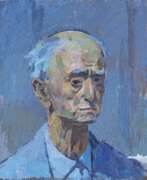

Bernhard Kretzschmar was a German painter and graphic artist.
Kretzschmar studied at the Dresden Academy, in 1920 destroyed most of his work and began his career anew. In 1932 he co-founded the Dresden Secession, but later the Social Democrats banned him as a degenerate artist, and his paintings were removed from museums and galleries. Kretzschmar hated the Nazis and had to flee the country.
Like many artists of his generation, he dabbled in Expressionism, then switched to Verismo. He skillfully tried his hand at both Futurism and Impressionism. He painted on the themes of social poverty, as well as comically depicting the bourgeois way of life. In 1945, most of his works were destroyed in an air raid.
After World War II, social motifs receded into the background and Kretzschmar focused more on landscapes, more often in the suburban areas of Dresden. He also painted several self-portraits with somber, skeptical and ironic facial expressions during his lifetime, which provide a vivid characterization of the artist.
From 1946, Bernhard Kretzschmar worked as a professor at the University of Fine Arts in Dresden. In 1959 he received the National Prize of the GDR, and since 1969 he has been a corresponding member of the German Academy of Arts in East Berlin.


Bruno Munari was an Italian painter, sculptor, graphic artist, designer, theorist, and educator.
He was called the orchestra man: Munari drew, illustrated, sculpted, photographed, designed advertisements, furniture and toys, wrote books, taught, made movies. Pablo Picasso called him the "new Leonardo."
As an inventor, Munari laid the foundations for many new kinds of visual art. For example, it was he who invented the suspended structures-mobiles that respond to the slightest fluctuations in the air, "useless machines" that are designed to distract the viewer from the everyday hustle and bustle.
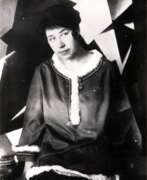

Lyubov Sergeyevna Popova (Russian: Любовь Сергеевна Попова) was a distinguished Russian avant-garde artist, celebrated for her pivotal role in the development of Cubism, Suprematism, and Constructivism during the early 20th century. Her innovative approach to art combined dynamic abstraction with geometric precision, reflecting the revolutionary spirit of her time. Popova's work transcends mere visual appeal, embodying the synthesis of artistic experimentation and the utopian ideals of her era.
Popova's artistic journey was marked by her relentless exploration of various mediums, including painting, textile design, and theater set design. Her contributions to art were not confined to her canvases; she actively participated in designing costumes and sets for theatrical productions, thereby influencing the visual language of Russian Constructivism. Her notable works, such as "The Traveler" and her series of "Painterly Architectonics," are celebrated for their bold use of color and form. These pieces, often showcased in prestigious galleries and museums worldwide, highlight her mastery of abstract composition and her ability to convey movement and depth through geometric shapes.
Popova's legacy extends beyond her artistic achievements. She was a key figure in the Artist School movement, where she dedicated herself to education and the dissemination of avant-garde principles. Her commitment to cultural innovation made her a central figure in discussions on the role of art in society, particularly in the context of the Russian Revolution. Today, collectors and experts in art and antiques revere Popova's work for its historical significance and its contribution to the evolution of modern art.
For enthusiasts and connoisseurs seeking to delve deeper into the world of avant-garde art, Lyubov Sergeyevna Popova's work remains a beacon of innovation and creativity. We invite you to sign up for updates on new product sales and auction events related to Popova's art. This subscription is an opportunity to stay informed about the latest discoveries and offerings in the realm of this groundbreaking artist.
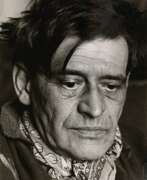

Jean Pougny, birth name — Ivan Albertovich Pougny (Russian: Иван Альбертович Пу́ни), was a Russian-French artist who changed his artistic manner several times during his artistic development from avant-gardism, cubism, futurism and suprematism to lyrical primitivism in the vein of a movement in which Pierre Bonnard and Édouard Vuillard also worked.
After World War I, Pouny emigrated via Finland to Germany and then to France, where he worked as a set designer for the Russian Ballet and collaborated with artists such as Le Corbusier.
Between 1921 and 1956, Puni had 12 solo exhibitions in Berlin, Paris, New York and London, and participated in over a hundred group exhibitions. In 1952, he was made a Knight of the Legion of Honour.
Jean Pugni's works are currently in the collections of major museums around the world.
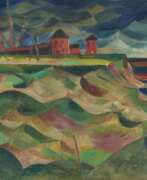

Paul Adolf Seehaus, also known as Barnett, was a German expressionist painter.
Under the guidance of expressionist August Mack (1887-1914) Seehaus mastered the styles of Fauvism, Cubism and Futurism. At the "Rhenish Expressionist Exhibition" in 1913, Seehaus earned the respect of critics as an independent expressionist painter. The talented young artist was expected to produce exciting new works, but sadly he died of pneumonia at the age of 27.
Paul Seehaus painted urban industrial landscapes, futuristic and rural views, and paintings on religious themes. His colors changed from a bright palette to a dark palette during the tragedy of World War I, but then he returned to optimistic watercolors.
As part of the Nazi "Degenerate Art" campaign of 1937, the Nazis withdrew some of Seehaus's expressive paintings from collections.
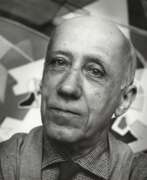

Gino Severini was an Italian painter and a prominent figure in the Futurist movement, known for his dynamic interpretation of movement and light in his artworks. Born in Cortona, Italy, in 1883, Severini moved to Paris in 1906, where he became deeply involved in the avant-garde scene, mingling with leading artists and embracing the vibrant cultural milieu of the city. His work often depicted lively urban scenes, dancers, and the energetic pace of modern life, distinguishing him within the Futurist movement for his unique focus on human figures and lively settings rather than the mechanical world.
Gino Severini's style evolved significantly over the years, moving from Futurism to incorporating elements of Cubism and later adopting a more classical approach in his art. After World War I, he aligned with the "return to order" movement, focusing on classical harmony and balance, which is evident in works like "The Two Pulchinellas." His later years saw him exploring various media, including mosaics and frescoes, contributing significantly to modern mosaic art and earning him the title "Father of Modern Mosaic."
Gino Severini's works are showcased in prestigious galleries worldwide, including the Museum of Modern Art (MoMA) in New York, where his influence on 20th-century art is celebrated. His contributions to art theory, his exploration across different art forms, and his ability to capture the essence of his time make Severini a fascinating subject for art collectors and experts alike.
For those interested in the evolution of modern art and the interplay between different artistic movements, Severini's work offers a compelling study of creativity and innovation. If you are intrigued by Gino Severini's contributions to the art world and wish to stay informed about upcoming sales and auction events related to his works, consider signing up for updates to deepen your knowledge and appreciation of this pivotal artist.
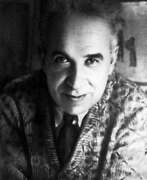

David Petrovich Shterenberg (Russian: Давид Петрович Штеренберг) was a Ukrainian-born Russian artist, recognized for his significant contributions to painting and graphic art. Born into a Jewish family in Zhitomir, Ukraine, Shterenberg's journey in art began in Odessa, leading him to Paris between 1906 and 1912, where he immersed himself in the vibrant artistic community. His studies at the Académie Vitti and interactions with notable artists like Kees van Dongen shaped his early artistic endeavors. Shterenberg's work, influenced by Paul Cézanne and Cubism, is celebrated for its expressive imagery, clear composition, and the strategic use of space.
Shterenberg's art evolved significantly over time, reflecting his deep engagement with the cultural shifts of his era. After returning to Russia post-1917 Revolution, he became an influential figure in Soviet art, leading the Department of Fine Arts at the People's Commissariat for Education and founding the Institute of Artistic Culture. Despite facing challenges under Soviet authority, which pushed him towards a more 'realistic' style, Shterenberg remained true to his unique artistic vision. His later years saw a return to themes of lyrical contemplation, notably in his Biblical Subjects series, completed before his death in 1948.
Today, Shterenberg's legacy lives on in major public galleries in Russia, including the Tretyakov Gallery, the Pushkin Museum, and the Russian Museum, as well as in private collections worldwide. His work encompasses a broad spectrum, from avant-garde experiments to intimate expressionist pieces, securing his place in the annals of modern art.
For enthusiasts and collectors alike, David Petrovich Shterenberg's oeuvre offers a rich exploration of early 20th-century art, marked by its innovative use of form and color, and its reflective engagement with the artist's cultural heritage and contemporary political landscape. Sign up for updates on new product sales and auction events related to Shterenberg, and discover more about this pivotal artist's contributions to the world of art.


Nikolai Mikhailovich Suetin (Russian: Николай Михайлович Суетин), a pivotal figure in Russian Suprematism, was celebrated for his innovative contributions to art, design, and ceramics. Born in 1897, Suetin's journey into the realms of avant-garde art began under the mentorship of Kazimir Malevich at the Vitebsk Higher Institute of Art. His dedication to Suprematism, an art movement emphasizing geometric forms and pure artistic feeling over representational elements, marked him as one of Malevich's most distinguished disciples.
Suetin's artistry was not confined to painting; he significantly impacted the design of ceramics and porcelain at the State Lomonosov Ceramics Factory, where he applied avant-garde principles to everyday objects, making Suprematism accessible beyond the canvas. His designs for the USSR pavilions at World Exhibitions in Paris (1937) and New York City (1939) showcased his versatility and ability to merge art with architectural spaces, illustrating his belief in the integration of art into daily life.
Notable works by Suetin include "Suprematist Composition with Black Rectangle," "Woman with a White Saw," and the "Scarecrow," along with innovative porcelain designs such as the "Suprematic Inkwell" and the "Tractor" service, embodying the essence of Suprematism through functional objects.
His legacy extends beyond his creations to his influence on the development of Russian modernist aesthetics and his efforts to infuse Suprematism into the fabric of Soviet culture. Suetin's work remains celebrated for its pioneering approach to abstract art and design, holding a permanent place in the annals of 20th-century art history.
For collectors and experts in art and antiques, Nikolai Mikhailovich Suetin represents a unique intersection of revolutionary artistic theory and practical application. His contributions continue to inspire and resonate, emphasizing the power of abstract forms and the potential of art to transcend conventional boundaries.
To stay informed about new product sales, auction events, and updates related to Nikolai Mikhailovich Suetin's work, signing up for updates offers an exclusive insight into the legacy and continued influence of this iconic artist.
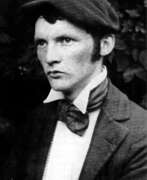

Heinrich Vogeler was a German artist and philosopher, a representative of the German Art Nouveau. A versatile and talented artist, he painted, watercolored, composed poems, designed, designed and decorated. Over time, his style of art changed over a wide range.
During World War I, from 1914 to 1917, Vogeler was on the Eastern Front as a volunteer and made sketches, which resulted in his pacifist sentiments.
In the mid-1920s he visited the Soviet Union several times and his impressions resulted in paintings in his own "complex style: "Karelia and Murmansk" (1926), "Building a New Life in the Soviet Republics of Central Asia" (1927), and "Baku" (1927). In 1931 Vogeler received an invitation to work in the USSR. The coming to power of the Nazis in Germany made it impossible for him to return home, and after Hitler's invasion Vogeler among many was deported to the Kazakh SSR, where he died.


Georgy Bogdanovich Yakulov (Russian: Гео́ргий Богда́нович Яку́лов) was a multifaceted Armenian artist renowned for his contributions across several artistic domains, including painting, graphic art, stage design, and art theory. Born on January 16, 1884, in Tiflis (now Tbilisi), Yakulov's work is celebrated for its abstract art and avant-garde approach, blending Eastern influences with European modernism. His art is notable for its abstract qualities, rich decorative colors, and a unique blend of romantic expressionism with a fascination for Oriental exoticism.
Yakulov's journey into the art world was marked by significant milestones, such as his studies at the Moscow School of Painting, Sculpture and Architecture, and his military service in northeast China, which introduced him to Eastern light effects and decoration. His artistic career flourished with exhibitions across Moscow, Paris, and Berlin, where he became associated with notable movements and figures, including the Delaunays and their theory of Simultanism.
A pivotal moment in Yakulov's career was his contribution to theatre, most notably his work with the Moscow Chamber Theatre and his designs for ballets, including those commissioned by Diaghilev for the Ballets Russes. This period highlighted his ability to merge traditional theatrical techniques with modernist abstraction, creating a lasting impact on stage design.
His theories, particularly the "Theory of Colored Suns," showcased his innovative approach to art, emphasizing the importance of light and color, which he explored through his essays and designs. Despite his passing on December 28, 1928, Yakulov's legacy endures through his contributions to modern art and theatre, with works displayed in notable galleries and a special place among avant-garde artists.
For art collectors and enthusiasts interested in exploring the rich tapestry of Eastern and European avant-garde movements, Georgy Bogdanovich Yakulov's work represents a fascinating convergence of cultures and artistic philosophies. To stay updated on new discoveries and exhibitions related to Yakulov, consider signing up for updates. This will ensure you're always informed about sales and auction events celebrating his remarkable legacy.
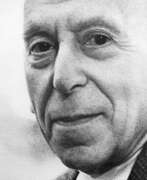

Léon Zak, birth name Lev Vasilyevich Zak (Russian: Лев Васильевич Зак), was a Russian poet, painter, graphic artist, stage designer and sculptor, theorist and ideologist of Futurism.
Leon Zak belonged to the Paris School. After years of figurative painting, his art moved increasingly towards abstraction. From 1950 he also turned to sacred art and created crucifixes, sculptures for church interiors and stained glass windows.


